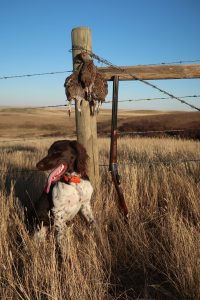I stared writing this post a few months ago, but got sidetracked. Now A.J. DeRosa published a thoughtful article on Project Upland I will limit myself to a condensed version.

“Did you get your limit?”
What goes through your mind when you hear that question? I am appealing to the bird hunter here, or perhaps broader, the small game hunter. For big game, the limit often is one (I’m ignoring Eastern states in the US where whitetails are thicker than mosquitoes), but for birds limits are common. Daily limits, possession limits, how many birds can you shoot in a day, and how many can have in your truck and freezer combined.
“Did you shoot a limit?”
Tips and tricks to “get your limit” are prevalent on the web. Photos of hunters with a limit of birds on their tailgates are a dime a dozen on Instagram. Full disclosure, I have done the latter myself. A limit of
pheasants in Alberta is two birds, and you will not have to go back too far in my feed to find those two birds proudly displaced. And nothing wrong with showing some pride in accomplishing a good day of hunting: the dog worked great, your shooting was on par, you had a good time out.
The potential problem lies in the fact that a lot of the hunting takes place on publicly accessible lands, with no control over who hunts, how often it gets hunted, or how many birds are taken other than the daily and possession limits. And as DeRosa points out, in many cases those limits were set long ago, and may not have been scrutinized in a while. What really got me agitated about this “getting a limit”, was an Instagram post a year or so ago, where the poster and friends proudly showed their limits of chukar, that were obtained in the valley, the birds driven down by snow, huddled together waiting out the storm. “We didn’t even have to climb!”
I realize I have mixed up two arguments here: the notion that we have no real control over hunting pressure on a limited resource (the number of hunters chasing the same coveys), and the lack of restraint that some of us display regardless of circumstances. Chukars under normal circumstances live in terrain that is difficult enough to make them fly further than the average hunter wants to pursue them, but it is not very hard for a few guys with half decent dogs to decimate a covey of huns, shooting a few from the initial rise and following up singles, till they reach the imposed limits. That covey may not recover. Especially not, if the next day another couple of guys hunt the same area and come across the stragglers. How much nicer would it be to just shoot a few from the covey, and move on to find a new one. You see more terrain, you can stay out longer, enjoy more fresh air, and pressure the birds a whole lot less. You may get a limit of birds, or you may not. But who cares if you have enjoyed a great day out?
It is a fine line between hunting smartly, and taking unfair advantage of circumstances. When it has been hot and dry, we might hunt near water. If it has been bitterly cold, we will look for pockets of open water to find migrating waterfowl. If the snow fell deep in the high country, we kill the huddled birds in the valleys. Somewhere along that spectrum, we went from smart to unsporting, or even to detrimental to survival of local populations. State or provincial/territorial agencies cannot control our actions at that point, it is up to the individual hunter to do a little soul searching and find that point when enough is enough.
Frans